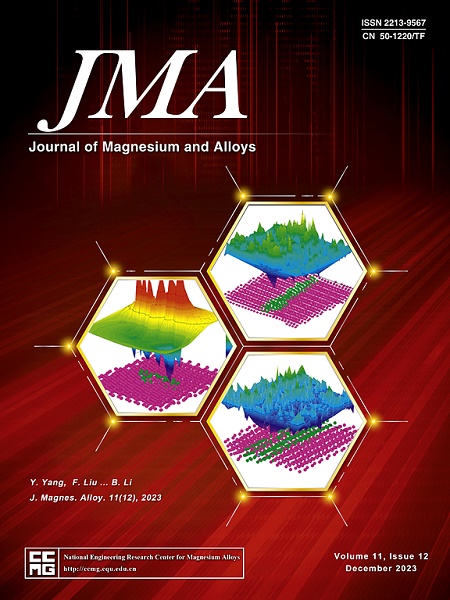Mechanisms of grain refinement and improved kinetic property of nanocrystalline Mg-Ni-La hydrogen storage alloys prepared by nanocrystallization of amorphous
IF 15.8
1区 材料科学
Q1 METALLURGY & METALLURGICAL ENGINEERING
引用次数: 0
Abstract
Mgx(Ni0.8La0.2)100-x, where x = 60, 70, 80, exhibiting a nanocrystalline microstructure, were prepared through the crystallization of amorphous alloys. The investigation encompassed the phase constitution, grain size, microstructural stability, and hydrogen storage properties. Crystallization kinetics, along with in-situ high-energy XRD characterization, revealed a concentrated and synchronous crystallization of Mg2Ni and RE-Mg-Ni ternary phases with the increase in La and Ni content. The attributed synchronous crystallization process was found to be a result of the close local affinity of Mg2Ni and RE-Mg-Ni ternary phases, as assessed by the thermodynamic Miedema model. Significant secondary phase pinning effect, arising from the high likelihood of well-matching phase structures between Mg2Ni, LaMg2Ni, and LaMgNi4, was validated through both the edge-to-edge matching model prediction and experimental observation. The fine and homogeneous microstructure was shown to be a consequence of fast crystallization kinetics and the secondary phase pinning effect. Improved activation performance and cycling stability were observed, stemming from grain refinement and excellent microstructural stability. Our study provides insights into mechanism of grain refinement of nanocrystalline microstructure tailored by phase constitution and crystallization kinetics in the amorphous-crystallization route. We also demonstrate the potential of material design guided by phase equilibria and crystallographic predictions to improve nanocrystalline with excellent microstructural stability.

非晶纳米化制备Mg-Ni-La储氢合金晶粒细化及动力学性能改善机理
通过非晶合金的晶化制备了Mgx(Ni0.8La0.2)100-x,其中x = 60、70、80,具有纳米晶结构。研究内容包括相组成、晶粒尺寸、显微组织稳定性和储氢性能。结晶动力学和原位高能XRD表征表明,随着La和Ni含量的增加,Mg2Ni和RE-Mg-Ni三元相集中同步结晶。根据热力学Miedema模型,发现同步结晶过程是由于Mg2Ni和RE-Mg-Ni三元相的密切局部亲和力造成的。通过边缘匹配模型预测和实验观察,验证了Mg2Ni、LaMg2Ni和LaMgNi4之间极有可能存在良好匹配的相结构,从而产生了显著的二次相钉住效应。细而均匀的微观结构是快速结晶动力学和二次相钉钉效应的结果。晶粒细化和优异的显微组织稳定性提高了活化性能和循环稳定性。我们的研究揭示了在非晶化路线中,由相组成和结晶动力学定制的纳米晶微观结构的晶粒细化机制。我们还展示了由相平衡和晶体学预测指导的材料设计的潜力,以改善具有优异微观结构稳定性的纳米晶体。
本文章由计算机程序翻译,如有差异,请以英文原文为准。
求助全文
约1分钟内获得全文
求助全文
来源期刊

Journal of Magnesium and Alloys
Engineering-Mechanics of Materials
CiteScore
20.20
自引率
14.80%
发文量
52
审稿时长
59 days
期刊介绍:
The Journal of Magnesium and Alloys serves as a global platform for both theoretical and experimental studies in magnesium science and engineering. It welcomes submissions investigating various scientific and engineering factors impacting the metallurgy, processing, microstructure, properties, and applications of magnesium and alloys. The journal covers all aspects of magnesium and alloy research, including raw materials, alloy casting, extrusion and deformation, corrosion and surface treatment, joining and machining, simulation and modeling, microstructure evolution and mechanical properties, new alloy development, magnesium-based composites, bio-materials and energy materials, applications, and recycling.
 求助内容:
求助内容: 应助结果提醒方式:
应助结果提醒方式:


